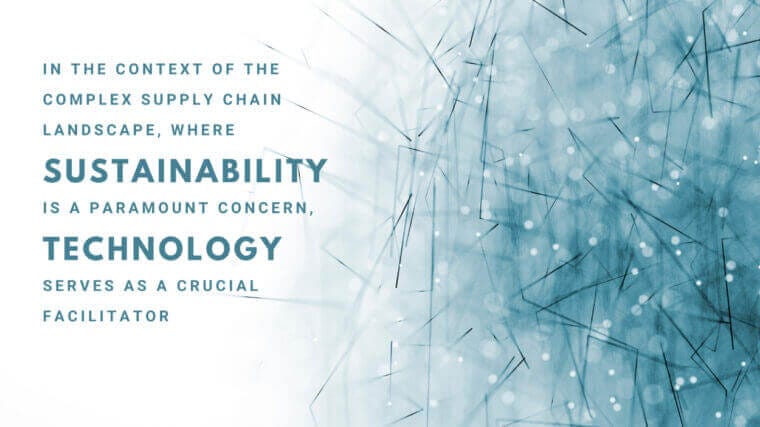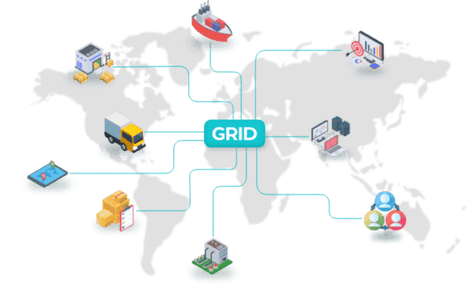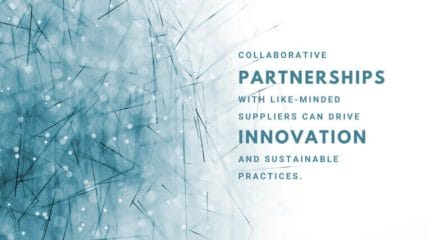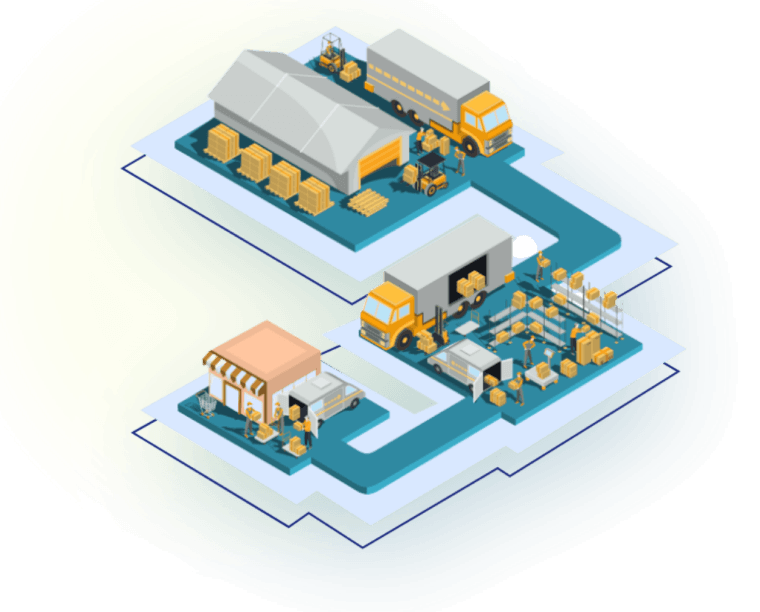Released in The Interline’s first Sustainability Report, this executive interview is one of a ten-part series that sees The Interline quiz executives from major companies on what the term ‘sustainability’ really means, as well as the integral role they play in supporting brands and retailers in their sustainability strategies.
Key Takeaways:
- The right supply chain technology stack can play a crucial role in helping stakeholders define and measure sustainability goals. It can empowers brands, retailers, and manufacturers to set well-defined objectives and establish measurable metrics through advanced data collection, analysis, and visualisation.
- Those strategic objectives are rarely well-served by existing technology ecosystems, that tend to create a more fragmented base of data to build both efficiency and sustainability strategies upon. Suuchi Inc. and its GRID platform are working to build what they refer to as a “next generation” supply chain technology stack.
- Sustainability strategies can coexist with profitability and even drive business performance and revenue growth. Sustainable practices lead to enhanced operational efficiency, cost savings, and the ability to attract a larger customer base.
Do you believe “sustainability” is still a useful term for defining the complex road that fashion needs to travel? What does that word mean to you, and how does your definition manifest itself in your company’s approach to designing solutions for fashion’s most urgent challenge?
Sustainability encapsulates the essential principles of minimizing environmental impact, promoting ethical practices, and ensuring long-term viability – all of which are critical components for the fashion industry’s evolution. Sustainability embodies the commitment to creating a balance between the demands of fashion and the needs of our planet and society. It means adopting practices that consider the full lifecycle of products, from sourcing raw materials to manufacturing, distribution, usage, and eventual disposal. It involves reducing waste, conserving resources, and mitigating the environmental and social consequences associated with traditional fashion practices.
In our company Suuchi Inc, and our flagship platform the GRID’s approach to designing solutions for fashion’s most urgent challenges, sustainability is deeply embedded. We recognize that the fashion industry faces pressing issues like overproduction, labor exploitation, and pollution. Our software platform is tailored to address these challenges by enabling supply chain transparency, traceability, and collaboration.
We offer features that allow brands to trace the origins of raw materials, monitor the environmental impact of manufacturing processes, and track products throughout their journey from production to end-users. This visibility empowers fashion companies to make informed decisions, optimize processes, and promote responsible practices at every step of the supply chain.
For the GRID, sustainability means enabling transparency, traceability, and collaboration. We empower brands to track materials, monitor environmental impact, and optimize processes. Our platform fosters partnerships to collectively address challenges, promoting responsible practices throughout the supply chain. Thus, sustainability is not just a term but a fundamental principle driving our approach to fashion’s urgent challenges.

Whether they are working to comply with legislation, or to move towards self-imposed targets, brands, retailers, and manufacturers need to be clear in how they define their sustainability objectives and in how they measure progress. What role do you see technology – and your GRID platform in particular – playing in helping different stakeholders to set and measure sustainability goals?
In the context of the complex supply chain landscape, where sustainability is a paramount concern, technology serves as a crucial facilitator. The GRID serves as a robust foundation for brands, retailers, and manufacturers striving to adhere to regulations or self-imposed benchmarks, and provides the ability to define and gauge sustainability objectives with precision. The GRID empowers stakeholders to articulate well-defined sustainability goals and establish measurable metrics. Through advanced data collection, analysis, and visualization, the platform provides a comprehensive view of environmental impact, ethical practices, and operational efficiency.
By leveraging the GRID capabilities, different stakeholders can streamline their efforts. Brands can collaborate more effectively with suppliers and manufacturers, aligning their goals and strategies. The GRID enables real-time monitoring, allowing stakeholders to track progress, identify areas for improvement, and make informed decisions to optimize their supply chain processes. The GRID fosters transparency and accountability. It enables stakeholders to share information, validate claims, and ensure the integrity of sustainability initiatives. This transparency builds trust among consumers and partners, enhancing brand reputation.
You can only measure what you do not track. In essence, the GRID platform allows companies to define, track, measure, and report against their sustainability goals. The GRID acts as a digital and measurement compass, guiding brands, retailers, and manufacturers through the intricacies of setting and measuring sustainability objectives. By harnessing GRID’s capabilities, stakeholders can navigate the journey towards a more sustainable future with clarity, precision, and collective commitment.
There’s a tendency in fashion to think that sustainability and profitability are incompatible with one another. Is that true, or do you believe that sustainability strategies can also directly drive business performance and revenue growth?
Sustainability strategies have the potential to not only coexist with profitability but also directly drive business performance and revenue growth. Sustainable practices often lead to enhanced operational efficiency, reduced waste, and optimized resource management. These improvements contribute to cost savings, which directly impact profitability. Today’s consumers are placing a premium on ethical and sustainable products. Brands that incorporate sustainability into their DNA can attract a larger customer base, foster loyalty, and command premium pricing. This aligns sustainability with revenue growth and increased brand value. Supply chain innovations driven by sustainability, such as circular economy practices and responsible sourcing, can lead to product differentiation and innovation. These initiatives create new revenue streams while minimizing the negative environmental impacts associated with traditional approaches.

Collaborative partnerships and supplier engagement, often central to sustainability strategies, can result in improved supplier relationships and more efficient processes. This translates to streamlined operations, reduced costs, and improved bottom-line performance. In the long term, sustainability strategies mitigate risks associated with regulatory changes, supply chain disruptions, and reputational damage. This risk reduction enhances business stability and contributes to sustained profitability.
The GRID provides tools to monitor, measure, and optimize sustainable practices. We firmly believe that as the fashion industry continues to evolve, sustainability will emerge not as a hindrance but as a catalyst for improved business performance, revenue growth, and a more responsible and resilient industry.
Fashion’s supply chains are unique in many respects, but the core idea of obtaining as much visibility and control over sourcing, manufacturing, and logistics – and using that visibility to create traceability that fuels transparency – are universal. What can fashion learn from how other industries have approached the same challenge of low initial availability of the supply chain data?
Fashion’s supply chains possess unique characteristics, but the fundamental goal of enhancing visibility and control over sourcing, manufacturing, and logistics is common across industries. Drawing from the experiences of other sectors facing similar challenges of limited initial supply chain data availability, the fashion industry can adopt similar methodology:
- Technology Adoption: Like industries such as electronics and automotive, fashion can harness technology such as IoT sensors and RFID tracking to capture real-time data at various stages of the supply chain, facilitating more comprehensive data collection.
- Data Standardization: Learning from the successes of sectors like food and pharmaceuticals, fashion can benefit from adopting standardized data formats. This consistency streamlines data exchange between stakeholders and systems.
- Collaboration and Partnerships: Industries like retail have excelled through collaborative efforts. By forming partnerships with suppliers and encouraging data sharing, fashion can collectively build a more complete view of the supply chain.
- Blockchain and Decentralization: Inspired by sectors like agriculture, fashion can explore blockchain technology to create an immutable record of transactions. This ensures transparency and enhances data integrity.
Regulation and Certification: Following the footsteps of sectors such as chemicals, fashion can implement regulatory frameworks and certification standards that mandate supply chain data reporting. This approach can catalyze data availability and transparency. - Data Analytics and AI: Learning from logistics and other sectors, fashion can leverage data analytics and AI to predict and mitigate supply chain disruptions. These tools empower proactive decision-making.
- Transparency Initiatives: Sectors like diamonds have established traceability systems for ethical sourcing. By emulating such initiatives, the fashion industry can enhance consumer trust by making its supply chain practices more visible.
These approaches collectively pave the way for enhanced visibility, control, traceability, and transparency across the fashion supply chain, contributing to more efficient and responsible operations.

A lot of organisations are currently faced with the urgent need to diversify and de-risk their supply chains, in pursuit of expansion, efficiency, or business protection. Can this be done without compromising sustainability strategies? And if so, how?
Achieving supply chain diversification and de-risking while maintaining sustainability objectives is attainable through a strategic and integrated approach. Organizations can achieve these goals by leveraging technology to gain data-driven insights into potential vulnerabilities and opportunities. Supplier assessment should extend beyond operational capabilities to include ethical and environmental considerations, aligning with sustainability strategies.
Collaborative partnerships with like-minded suppliers can drive innovation and sustainable practices. Circular economy principles, such as recycling and remanufacturing, can minimize waste and enhance supply chain resilience, seamlessly aligning with sustainability goals. Transparency and traceability, facilitated by supply chain software platforms, aid in monitoring sustainability performance across the extended network.
To navigate regulatory variations, ensure that suppliers comply with relevant sustainability standards in different regions. Incorporating risk mitigation strategies addresses potential disruptions to both diversification and sustainability efforts. Scenario planning anticipates challenges and devises strategies for alignment.
Continuous improvement remains essential, and businesses need to regularly assess and refine their strategies to uphold evolving sustainability priorities. Engaging stakeholders, including customers and partners, fosters support for the sustainable diversification journey. Ultimately, an integrated approach considers technology, partnerships, circular practices, data insights, and stakeholder involvement to ensure that expansion, efficiency, and risk mitigation complement responsible and sustainable business practices.
For a lot of fashion businesses, compliance with regional regulations is the priority target, but long-term sustainability is about individual and collective action to rapidly improve fashion’s environmental and ethical credentials. What do you think the future looks like at that whole-industry level? And what does that mean for your roadmap and your customers?
The future of the fashion industry at a whole-industry level holds a promising trajectory towards a more sustainable and ethical landscape. While immediate compliance with regional regulations remains a priority for many fashion businesses, the long-term outlook envisions a shift towards proactive and collective action to significantly enhance the industry’s environmental and ethical standing.
The fashion industry will likely witness increased collaboration among stakeholders. Brands, manufacturers, suppliers, and consumers will come together to drive systemic changes that address the challenges of waste, pollution, labor conditions, and resource depletion. This collaborative approach will extend beyond compliance and move towards embracing shared responsibilities for the entire supply chain.

For Suuchi Inc. and our customers, this vision translates into a dynamic roadmap that centers on sustainability. Our platform will evolve to facilitate not only regulatory compliance but also the adoption of sustainable practices throughout the supply chain. Key elements of our roadmap include:
- Enhanced Data Visibility: Our platform will provide deeper insights into the environmental and ethical aspects of supply chain operations, aiding brands and partners in making informed decisions.
- Traceability and Transparency: We will further develop traceability capabilities, allowing customers to track materials, processes, and conditions, enhancing transparency for consumers.
- Collaboration Tools: Our roadmap will focus on fostering collaboration, enabling stakeholders to share best practices, innovative solutions, and collective strategies for sustainable growth.
- Metrics and Reporting: We will refine our metrics and reporting features, enabling customers to measure and communicate their progress towards sustainability goals to stakeholders, investors, and consumers.
- Innovation Integration: Our platform will seamlessly incorporate emerging technologies and circular economy practices to support customers in adopting innovative, environmentally conscious approaches.
Ultimately, the future of the fashion industry envisions a collaborative and sustainable ecosystem, wherein our supply chain software platform serves as a pivotal enabler. Our roadmap will be driven by the industry’s transformation towards individual and collective actions that promote environmental stewardship and ethical practices, ensuring that we continue to empower our customers in shaping a more responsible and sustainable future for fashion.
Visit the full article on Interline website.
